The Intel Skylake i7-6700K Overclocking Performance Mini-Test to 4.8 GHz
by Ian Cutress on August 28, 2015 2:30 PM ESTCPU Tests on Windows: Professional
Cinebench R15
Cinebench is a benchmark based around Cinema 4D, and is fairly well known among enthusiasts for stressing the CPU for a provided workload. Results are given as a score, where higher is better.

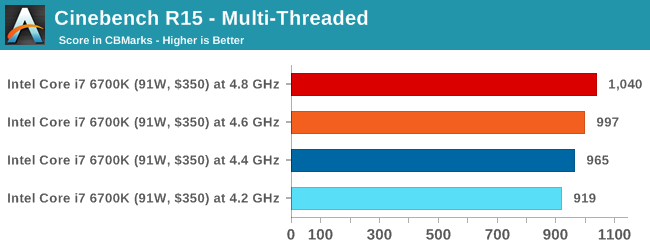
Agisoft Photoscan – 2D to 3D Image Manipulation: link
Agisoft Photoscan creates 3D models from 2D images, a process which is very computationally expensive. The algorithm is split into four distinct phases, and different phases of the model reconstruction require either fast memory, fast IPC, more cores, or even OpenCL compute devices to hand. Agisoft supplied us with a special version of the software to script the process, where we take 50 images of a stately home and convert it into a medium quality model. This benchmark typically takes around 15-20 minutes on a high end PC on the CPU alone, with GPUs reducing the time.
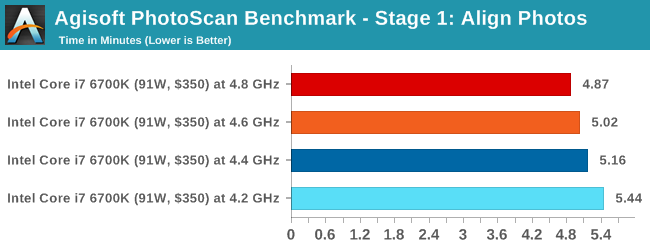
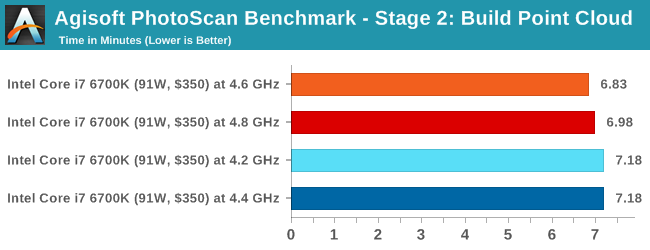
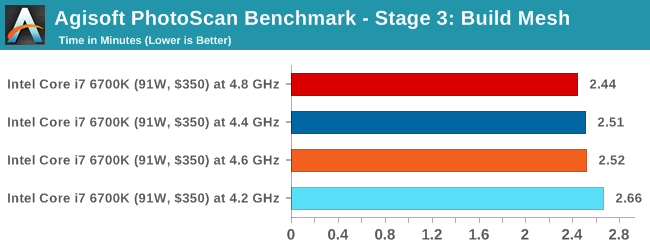
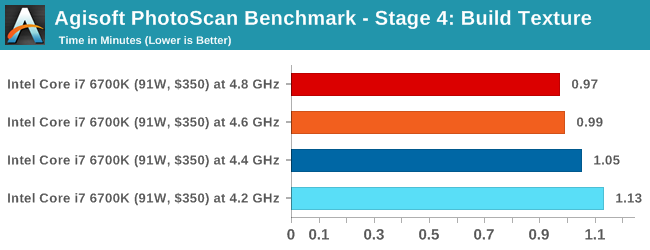
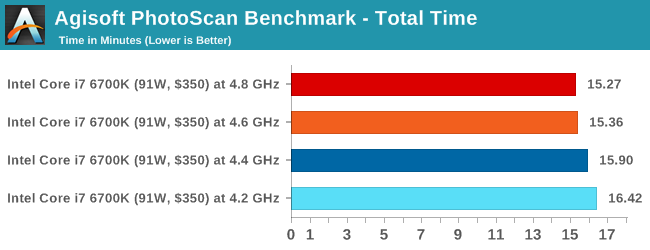
Rendering – PovRay 3.7: link
The Persistence of Vision RayTracer, or PovRay, is a freeware package for as the name suggests, ray tracing. It is a pure renderer, rather than modeling software, but the latest beta version contains a handy benchmark for stressing all processing threads on a platform. We have been using this test in motherboard reviews to test memory stability at various CPU speeds to good effect – if it passes the test, the IMC in the CPU is stable for a given CPU speed. As a CPU test, it runs for approximately 2-3 minutes on high end platforms.
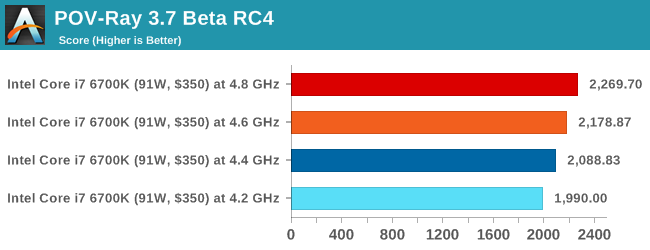
HandBrake v0.9.9 LQ: link
For HandBrake, we take a 2h20 640x266 DVD rip and convert it to the x264 format in an MP4 container. Results are given in terms of the frames per second processed, and HandBrake uses as many threads as possible.
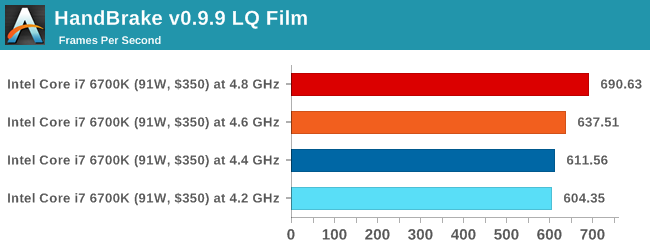
Conclusions on Professional Performance
In all of our professional level tests, the gain from the overclock is pretty much as expected. Photoscan sometimes offers a differing perspective, but this is partly due to some of the randomness of the implementation code between runs but also it affords a variable thread load depending on which stage. Not published here are the HandBrake results running at high quality (double 4K), because it actually failed at 4.6 GHz and above. There is a separate page addressing this stability issue at the end of this mini-review.










103 Comments
View All Comments
Zoeff - Friday, August 28, 2015 - link
As an owner of a 6700K that's running at 4.8GHz, this is a very interesting article for me. :)I've currently entered 1.470v in the UEFI and I can get up to 1.5v in CPUz. Anything lower and it becomes unstable. So I guess I'm probably on the high side voltage wise...
zepi - Friday, August 28, 2015 - link
Sounds like a scorching voltage for 24/7 operations considering it is 14nm process... But obviously, we don't really know if this is detrimental on longer term.0razor1 - Friday, August 28, 2015 - link
I believe it is. Ion shift. High voltage = breakdown at some level. Enough damage and things go amiss.When one considers 1.35+ for 22nm high, I wonder why we're doing this (1.35+) at 14nm.
If it's OK, then can someone illustrate why one should not go over say 1.6V on the DRAM in 22nm, why stick to 1.35V for 14nm? Might as well use standard previous generation voltages and call it a day?
Further, where are the AVX stable loads? Sorry, but no P95 small in place FFTs with AVX = NOT stable enough for me. It's not the temps ( I have an h100i) for sure. For example, on my 4670k, it takes 1.22VCore for 4.6GHz, but 1.27VCore when I stress with AVX loads ( P95 being one of them).
It's *not* OK to say hey that synthetic is too much of a stress etc. I used nothing but P95 since K-10 and haven't found a better error catcher.
0razor1 - Friday, August 28, 2015 - link
To add to the above, downclocking the core on GPU's and running memcheck in OCCT is *it* for my VRAM stability tests when I OC my graphics cards. I wonder how people just 'look' for corruption in benchmarks like firestrike and call their OC's stable. It doesn't work.Run a game and leave it idle for ~ 10 hours and come back. You will find glitches all over the place on your 'stable' OC.
Just sayin- OC stability testing has fallen to new lows in the recent past, be it graphic cards or processors.
Zoeff - Friday, August 28, 2015 - link
I tend to do quick tests such as Cinebench 15 and HandBrake, then if that passes I just run it for a week with regular usage such as gaming and streaming. If it blue screens or I get any other oddities I raise the voltage by 0.01v. I had to do that twice in the space of 1 week (started at 1.45v, 4.8GHz)Oxford Guy - Saturday, August 29, 2015 - link
That's a great way to corrupt your OS and programs.Impulses - Saturday, August 29, 2015 - link
Yeah I do all my strenuous testing first, if I have to simulate real world conditions by leaving two tests running simultaneously I do it too... Like running an encode with Prime in the background; or stressing the CPU, GPU, AND I/O simultaneously.AFTER I've done all that THEN I'll restore a pre-tinkering OS image, unless I had already restored one after my last BSOD or crash... Which I'll do sometimes mid-testing if I think I've pushed the OC far enough that anything might be hinky.
It's so trivial to work with backups like that, should SOP.
Oxford Guy - Sunday, August 30, 2015 - link
If a person is using an unstable overclock for daily work it may be hard to know if stealth corruption is happening.kuttan - Sunday, August 30, 2015 - link
haha that is funny.kmmatney - Saturday, September 19, 2015 - link
I do the same as the OP (but use Prime95 and Handbrake). If it passes a short test there (say one move in Handbrake) I just start using the machine. I've had blue screens, but never any corruption issues. I guess corruption could happen, but the odds are pretty low. My computer gets backed up every night to a WHS server, so I can be fearless..